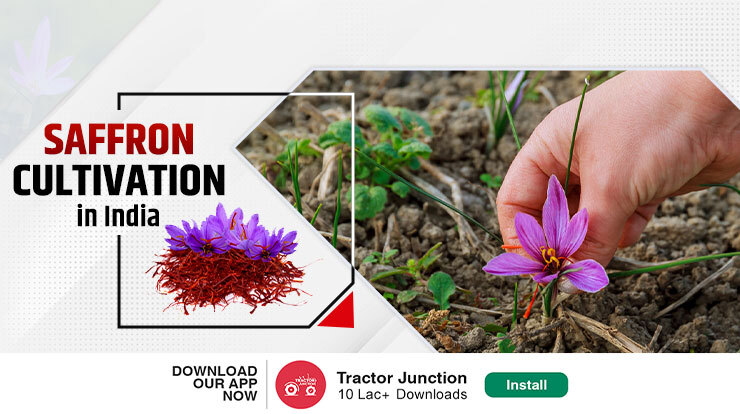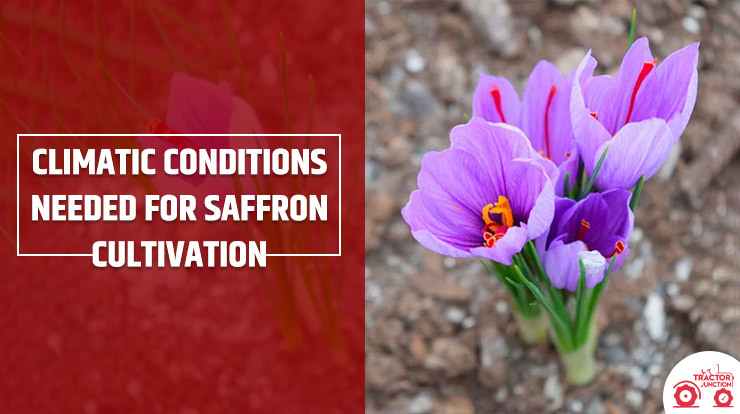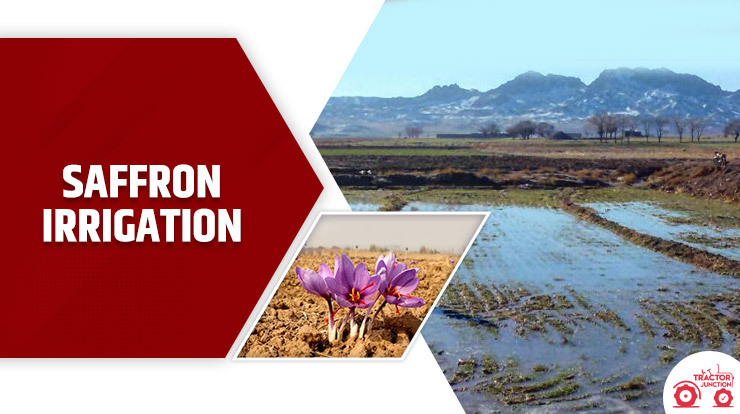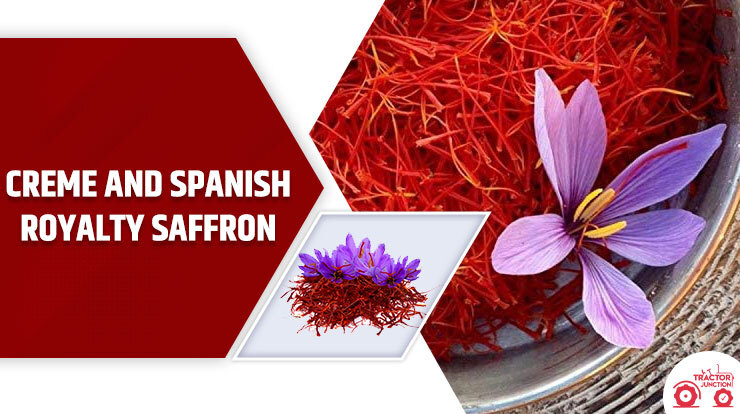
Saffron is a spice obtained from the flower of Crocus Sativus, aka saffron crocus. The spice contains the dried stigmas of the flower.
Saffron flowers are hand-picked and thereafter dried, making them ready to use for cooking and seasoning. This process is called saffron cultivation. Its production requires specific climatic conditions like:
- Mediterranean climate
- Cool temperatures
- well-drained soil like sandy loam or calcareous soil
The flower typically blooms in the fall. Moreover, the stigmas must be carefully hand-picked and dried before they can be used as spice.
Above all, Saffron is considered one of the most expensive spices in the world. This is because of its laborious production process. Both during cultivation and harvesting.
Planning to go for saffron cultivation? Here’s a complete beginner’s guide catering to all your questions regarding saffron cultivation.
Best Farming Tractors Suitable for Saffron Cultivation!
Factors Affecting Saffron Cultivation in India:

As discussed above, there’s an entire checklist when it comes to saffron farming in India. Hence, below are a few factors to consider for getting high-yielding Saffron.
1. Water
Saffron requires a constant water supply. However, too much water can damage the crop.
Additionally, during its growth phase, Saffron requires utmost care. For instance, the plant gets vulnerable to intense low temperatures or snowfall. This is because, in spring, it requires moisture in abundance till blooming.
Therefore, one should water it on a weekly basis, around 1.2cm. Given the duration of 160 days in the growth phase.
Systematic Irrigation should be practised in order to ensure adequate water supply.
2. Climate
Cool climatic conditions with high humidity levels are ideal for the cultivation of Saffron in India.
In other words, Mediterranean-like climates are fit for this spice’s production. Moreover, check for the temperature and ensure it’s below 16 ℃. This is because warmer temperatures may delay budding.
So, this was all about temperature for saffron cultivation.
3. Soil
Saffron grows best in loose and well-drained soil. For instance, sandy-loamy or calcareous soil. This is because powdery soil leads to better root health.
Moreover, it accelerates drainage. Besides, a plus point would be the one with high organic content.
Talking about the pH, this plant prefers a pH range of 6-7, given the moisture is minimal.
So, these were the basic factors a farmer should consider for saffron farming. Now, let’s discuss some caring guidance for a saffron plant in India.
Saffron Cultivation in India: Plantation Methods & Caring Guidance

Be it a yellow saffron plant or any other of that sort. It would need utmost care. Therefore, below are some of the basic caring guidelines for saffron cultivation.
1. Saffron Seeding & Planting

The sowing of saffron plant seeds differs in terms of plant species. Hence, saffron cultivation time differs.
For instance, late summer is suitable weather for fall flowering plants.
On the contrary, spring flowering Saffron requires the plantation before six to nine weeks of first snow cover. Now talking about the singular corms.
Plant the corms about 8-10 centimetres under the soil.
Apart from planting, spacing is important as well. Separate the corms by 5 to 10 cm or between 15- 20 cm. This should depend upon the area of the plantation. Moreover, super seeder machines are best when it comes to obtaining high-yield saffron.
Additionally, one can go for saffron vertical farming in India.
2. Water

Watering has to be consistent when talking about saffron cultivation. Simply put, follow this consistency during spring and winter fall.
The plant is not in action during the summer. Nevertheless, it would still require basic watering. However, make sure not to go overboard with watering.
Additionally, water also comes into play after placing the plant. Hence, do not forget to water right after you set the corms at a desired location.
Furthermore, consider watering the corms on a weekly basis during their growth phase. The overall idea is to not let the plant bed get dry in winter.
3. Fertiliser
The way you add fertilisers to your corms says a lot about your final saffron tree plant. More specifically, if your aim is to get a bigger stigma or petal size.
Fertilise your plantation twice when it’s in a growing phase. The first course should be during the fall. Go for the second course during early spring. Furthermore, opt for good quality sprayer implements for better application of fertiliser in the field.
4. Harvesting

To begin with, the best time for harvesting saffron plants is between mid to late spring. Morning is the best time for cutting open flowers. Moreover, the knowledge of different types of harvesters is a plus point for farmers going for saffron cultivation.
Note: Hand-picking the stigmas is a must. Or else you would not be able to separate the threads from the flowers.
Hence, you need to jot this point down when it comes to saffron crop cultivation.
After handpicking the threads, keep them under sunlight for a week. Later, use an airtight container to store the product for 30 days at least.
Moreover, Saffron is prone to pests. Hence, disease and pest control should be in check from time to time.
For instance, ignorance of this measure can encourage saffron beetles’ growth on the plantation. As a result, it can severely damage the crop.
These were the major saffron cultivation practices in India. Now, let’s move towards the different kinds and profit potential from this commercial crop.
What Are the Main Types of Saffron Plants?
The three wide varieties of saffron plants are:
- Lacha or Mongra Saffron
- Aquila Saffron
- Spanish & Creme Saffron
Let’s get some basic information about each one of the varieties.
1. Lacha or Monga Saffron

Lacha Saffron generally has a dark crimson-red-like colour. Kashmir region of India has its sole plantation.
Moreover, it is the darkest Saffron globally by colour. Additionally, its long-lasting aroma and flavour make it the best saffron variety in the world.
Note: This saffron type is only available in India.
2. Aquila Saffron

It is often identified as the Iranian Saffron. This is because Iran is the largest producer of this saffron variety in the world.
Moreover, Italy also produces this Saffron variety.
Talking about its characteristics, it has a shorter thread. Besides, its colour is lighter, however high in quality.
3. Creme and Spanish Saffron

The United States is the largest consumer of this saffron variety. It is comparatively less pricey than the other saffron types.
This is because its style has more yellow parts and leaves higher flower waste.
And here’s a thing about Saffron…
It’s called a sunshine spice. Rightly so due to multiple reasons. It’s because it carries high nutritional value, often acting as an antioxidant.
Besides, its pungent aroma adds flavour to delectable cuisines. More importantly, it’s a highly profitable crop for Indian farmers, adding value to the GDP.
Considering these benefits, let’s talk in detail– Why and how Saffron is a profitable crop for Indian farmers.
Why Go For Saffron Cultivation? Benefits & Profits Explained
Below listed are the major benefits of this spice, followed by the profit of saffron plants in India.
Saffron Benefits:
- Fights free radicals
- Rich in Vitamins and folic acid
- Relieves depressive symptoms
- It may help fight cancer
- Improves memory and concentration
- Can improve hair-growth
- Relieves PMS ailments
- Protects your body against cold
- Aids Arthritis
- Can improve eye vision
- It may cure sleeplessness or chronic insomnia
- Aids in digestion
- Heals wounds from minor injuries
Saffron Profits

Saffron’s multitasking properties make it a highly profitable crop among Indian farmers. However, Saffron has a lot more to give.
In India, 1kg of 100% pure saffron is retailed for about INR 3,00,000.
For instance, it’s additionally used in medicines, dyes, cosmetics, and the tobacco industry. Hence, giving the farmers an array of reasons to do saffron farming in a greenhouse.
Furthermore, cultivation of Saffron makes about $800 profit just in grocery stores in the US.
Besides, saffron hydroponic farming yields higher profits for Indian farmers. Apart from hydroponics, saffron cultivation in polyhouse is a profitable alternative too.
Top Saffron Producing States in India

Jammu and Kashmir is the largest Saffron producing state in India. Moreover, Himachal Pradesh also comes among the top saffron cultivation states in India.
Additionally, Saffron has different names in different states. It’s called:
- Kesar in Hindi.
- Asra or Kunkuma in Sanskrit.
- And Zafran in Urdu.
- Local Kashmiri folks call it “Kong,” and Keshar in Gujarati.
Kashmir Adapts The Indoor Saffron Farming

Climate change has significantly affected saffron pricing in India. This phenomenon made agricultural scientists & farmers go for indoor saffron cultivation.
This is a relatively new technique. Nevertheless, the results are quite promising.
Abdul Majeed, a farmer from Shaar-i-Shalli village of Kashmir, shares his experience of adopting indoor saffron farming.
He regularly checks the quality of the saffrons he has cultivated indoors. He shared how he has been doing this indoor farming for the past 3 years now.
“This indoor saffron cultivation technique has benefited us a lot in a good way.”
He further shared how the saffron yields are fine & of the best quality. And once fully blossomed, those are placed and sheltered inside carefully.
Wrapping Up
This blog walked you through the nuances of saffron cultivation. Right from understanding the factors required for saffron cultivation, we discussed farming methods.
Proceeding further, we discussed its benefits and profitability for Indian farmers. Thereafter, we also covered the major Indian states producing Saffron.
More importantly, we learnt how agro scientists are now switching to saffron indoor farming. And how it continues to be a beneficiary method for farmers, especially in Kashmir.
Our farmers are giving their best in terms of saffron cultivation. Additional support from the government can further accelerate its production. For instance, subsidies in terms of equipment and seeds. Moreover, the government can invest more in R&D to boost saffron yield per acre. Export-centric schemes should be introduced and implemented to increase the demand for Indian Saffron in global markets.
To cultivate the absolute quality Saffron plants in India, make sure you update your farming tractors and implements from the best brands.
Frequently Asked Questions
Ques. Which soil is suitable for saffron cultivation?
Ans. In India, sandy loam soil or calcareous clay soil is best for saffron cultivation. It’s because this soil is loose and well-drained, especially during winter.
These soils are found in temperate regions of India. Soils like silty clay soil contain high PH levels, henceforth leading to high-quality Saffron.
Ques. Why is Saffron so expensive?
Ans. It is expensive as typically; it takes 75,000 saffron to produce 1 pound of Saffron. This is because only a small part of the flower is used in the production of Saffron.
Hence, a small quantity, per plant makes Saffron an expensive spice. Moreover, it requires manual harvesting. Hence, justifying the high pricing of saffron seeds for cultivation.
Ques. How much can Saffron 1-acre produce?
Ans. Asking about saffron farming profit per acre is a common question. In India, one can obtain about 8 to 10 pounds of dried Saffron from one acre of land. Given it should be a yearly yield.
Ques. Saffron is obtained from which part of the plant?
Ans. A flower, Crocus Sativus, produces Saffron. It is conventionally known as saffron crocus within the farming community.
Thereafter, thread-like structures- vivid crimson stigma and styles are assorted together. Afterwards, these are dried and ready to use. Typically as a food seasoning or act as a natural food colouring agent.
Ques. Are saffron seeds for farming profitable in India?
Ans. Saffron cultivation is one of the most lucrative crops for Indian farmers. It is highly profitable as this spice brings in about USD 29,000/ kg.
Furthermore, one can grow saffron post-fall harvest. Therefore, it’s often a boon for people looking for an alternative source of income.
Ques. What is the benefit of Saffron?
Ans. Saffron is more than a luxury spice. It brims several nutritional values along. And is overall a great medicinal herb for our body.
Acting as an antioxidant, it helps fight free radical damage and may prevent cancer. Additionally, it can alleviate stress by improving mood.
Moreover, Saffron is known for relieving PMS. Sometimes it often acts as an aphrodisiac.
Related Post
Ashwagandha Farming in India
Kiwi Fruit Farming in India
